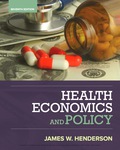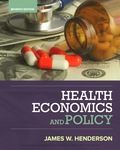
(a)
The key screening strategies and the reason for them to be important than others.
(a)
Explanation of Solution
As per the table, option 1, 3 and 6 could be considered as dominant options. In option 1 it is true that there is an incremental cost. Nevertheless, its QALY value is positive. Hence it could be considered as dominant. Further, in option 3, a positive QALY has been derived with an incremental cost that is considerably low. In option 6, both the tests could be done. However, the incremental cost involved does not seem alarming. Its QALY value is also a positive figure.
Introduction:
When selecting between various treatment options, it is important to look into various measures that make them dominant. In this case, the cost of the treatment as well as the QALY value has been looked into. QALY or Quality Adjusted Life Year is a weighted average measure that takes into account both the qualitative and quantitative aspects of the burden of a disease. This is helpful in determining the level of medical intervention needed.
(b)
The incremental cost values, incremental QALY values and incremental cost effective ratios for the treatment options that seem to be economically rationale and state why they are so.
(b)
Explanation of Solution
As per the table, option 3 and 6 seems to be economically rationale. Option 3 has an incremental value that is considerably low, together with a positive QALY value. Option 6 too consists of a somewhat lower incremental cost with a positive QALY value. Hence both these options could be considered as economically rational.
Introduction:
In determining the economically rational treatment options out of a list, it is important to consider measures such as the incremental cost, incremental QALY and the incremental cost effectiveness ratio. An economically rational option would ideally have a lower incremental cost and a positive QALY value.
(c)
The best strategy to be recommended from a standpoint of public health.
(c)
Explanation of Solution
As per the table, option 6 could be considered the best strategy to be recommended from a public health standpoint. The option included both the tests Pap and HPV, with a reasonable incremental cost as well as a positive QALY value. Hence it could be recommended as the best strategy.
Introduction:
When recommending health strategies from the perspective of public health, it is important that they address to the needs of a wider population, at a lower cost. In this regard, out of the strategy options given, the one with a considerably low incremental cost together with a positive QALY value must be selected.
Want to see more full solutions like this?
Chapter 4 Solutions
EBK HEALTH ECONOMICS AND POLICY
- Your marketing department has identified the following customer demographics in the following table. Construct a demand curve and determine the profit maximizing price as well as the expected profit if MC=$1. The number of customers in the target population is 10,000. Use the following demand data: Group Value Frequency Baby boomers $5 20% Generation X $4 10% Generation Y $3 10% `Tweeners $2 10% Seniors $2 10% Others $0 40%arrow_forwardYour marketing department has identified the following customer demographics in the following table. Construct a demand curve and determine the profit maximizing price as well as the expected profit if MC=$1. The number of customers in the target population is 10,000. Group Value Frequency Baby boomers $5 20% Generation X $4 10% Generation Y $3 10% `Tweeners $2 10% Seniors $2 10% Others $0 40% ur marketing department has identified the following customer demographics in the following table. Construct a demand curve and determine the profit maximizing price as well as the expected profit if MC=$1. The number of customers in the target population is 10,000.arrow_forwardTest Preparation QUESTION 2 [20] 2.1 Body Mass Index (BMI) is a summary measure of relative health. It is calculated by dividing an individual's weight (in kilograms) by the square of their height (in meters). A small sample was drawn from the population of UWC students to determine the effect of exercise on BMI score. Given the following table, find the constant and slope parameters of the sample regression function of BMI = f(Weekly exercise hours). Interpret the two estimated parameter values. X (Weekly exercise hours) Y (Body-Mass index) QUESTION 3 2 4 6 8 10 12 41 38 33 27 23 19 Derek investigates the relationship between the days (per year) absent from work (ABSENT) and the number of years taken for the worker to be promoted (PROMOTION). He interviewed a sample of 22 employees in Cape Town to obtain information on ABSENT (X) and PROMOTION (Y), and derived the following: ΣΧ ΣΥ 341 ΣΧΥ 176 ΣΧ 1187 1012 3.1 By using the OLS method, prove that the constant and slope parameters of the…arrow_forward
- QUESTION 2 2.1 [30] Mariana, a researcher at the World Health Organisation (WHO), collects information on weekly study hours (HOURS) and blood pressure level when writing a test (BLOOD) from a sample of university students across the country, before running the regression BLOOD = f(STUDY). She collects data from 5 students as listed below: X (STUDY) 2 Y (BLOOD) 4 6 8 10 141 138 133 127 123 2.1.1 By using the OLS method and the information above derive the values for parameters B1 and B2. 2.1.2 Derive the RSS (sum of squares for the residuals). 2.1.3 Hence, calculate ô 2.2 2.3 (6) (3) Further, she replicates her study and collects data from 122 students from a rival university. She derives the residuals followed by computing skewness (S) equals -1.25 and kurtosis (K) equals 8.25 for the rival university data. Conduct the Jacque-Bera test of normality at a = 0.05. (5) Upon tasked with deriving estimates of ẞ1, B2, 82 and the standard errors (SE) of ẞ1 and B₂ for the replicated data.…arrow_forwardIf you were put in charge of ensuring that the mining industry in canada becomes more sustainable over the course of the next decade (2025-2035), how would you approach this? Come up with (at least) one resolution for each of the 4 major types of conflict: social, environmental, economic, and politicalarrow_forwardHow is the mining industry related to other Canadian labour industries? Choose one other industry, (I chose Forestry)and describe how it is related to the mining industry. How do the two industries work together? Do they ever conflict, or do they work well together?arrow_forward
- What is the primary, secondary, tertiary, and quaternary levels of mining in Canada For each level, describe what types of careers are the most common, and describe what stage your industry’s main resource is in during that stagearrow_forwardHow does the mining industry in canada contribute to the Canadian economy? Describe why your industry is so important to the Canadian economy What would happen if your industry disappeared, or suffered significant layoffs?arrow_forwardWhat is already being done to make mining in canada more sustainable? What efforts are being made in order to make mining more sustainable?arrow_forward
- What are the environmental challenges the canadian mining industry face? Discuss current challenges that mining faces with regard to the environmentarrow_forwardWhat sustainability efforts have been put forth in the mining industry in canada Are your industry’s resources renewable or non-renewable? How do you know? Describe your industry’s reclamation processarrow_forwardHow does oligopolies practice non-price competition in South Africa?arrow_forward

 Exploring EconomicsEconomicsISBN:9781544336329Author:Robert L. SextonPublisher:SAGE Publications, Inc
Exploring EconomicsEconomicsISBN:9781544336329Author:Robert L. SextonPublisher:SAGE Publications, Inc Economics (MindTap Course List)EconomicsISBN:9781337617383Author:Roger A. ArnoldPublisher:Cengage Learning
Economics (MindTap Course List)EconomicsISBN:9781337617383Author:Roger A. ArnoldPublisher:Cengage Learning






